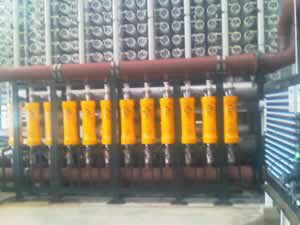Simplicity
We make too much of feeling, even admitting that
the right kind of feeling is very enjoyable. What does it
matter how you feel? Bear your lot as long as it is the
will of God that you should do so. Act rightly, and in
due time the right feeling of peace and joy will come.–Sri Gyanamata, “God Alone: The Life and Letters
of a Saint”
Pakistan floods reveal deep-rooted problems
Co-operation with countries in the Indus basin for building storage dams, flood control installations and power generation stations will help Pakistan.
Santosh Kumar
Manohar Khushalani
The floods in Pakistan may have abated but the havoc caused by them continues to mount. Nearly 21 million, or 13 per cent of Pakistan’s population, and 20 per cent of its area have been affected. About 1.85 million homes have been destroyed or damaged in a country where a large percentage of the population live as refugees. UN experts estimate that 2.7 million people in Khyber Pakhtunkhwa, 5.3 million in Punjab and 4.4 million in Sindh need immediate humanitarian assistance.
The damage caused to agricultural land and livestock will take years to set right. Approximately four out of five people in the flood-affected areas depend on agriculture for their livelihood. An estimated 700,000 acres of cotton, 200,000 acres each under rice and sugarcane and 300,000 acres of wheat crops have been destroyed. This will severely affect the agricultural economy, which accounted for 20.4 per cent of Pakistan’s GDP last year. The cascading effects on industry and trade are bound to add to the economic woes.
Relief efforts
The political spillover is equally, if not more, worrisome. Relief efforts highlight the inefficiencies and corruption endemic in the Pakistani administrative set-up, magnified as they are in the eyes of the already disenchanted masses, especially the internally displaced. The fear is that fundamentalist organisations will extend their grip over the affected populace by filling the wide gaps in disaster relief left by the Pakistan Government and international relief agencies.
Even if Pakistan tides over the after-effects of these floods, can it prevent another such disaster? Pakistani meteorological data point to the unusually heavy rains in July-August in the Khyber Pakhtunkhwa and Punjab provinces as the main cause of the floods. The precipitation map released by USAID corroborates this.
Indus River basin
The flood-affected areas are mostly along the main Indus River and its western tributaries — Swat and Kabul — and less so along the eastern tributaries — Jhelum, Chenab and Sutlej.
This should not, however, obscure the larger picture. More than 80 per cent of the total water flows in the Indus River system. The water originates from snowmelt and rainfall in the wider mountainous arc, which includes Afghanistan, India and China.
According to one estimate, the Kabul River accounts for 20-30 maf (million acre-feet) of total annual flows, the main Indus 100 maf, the Jhelum and Chenab 60 maf, while the Ravi, Beas and Sutlej add another 40 maf or so.
Floods are a cumulative effect of all these flows and are triggered almost annually, with constant siltation reducing the rivers’ capacity to hold these waters. Rising precipitation levels over the long term are likely to result in even more unmanageable discharges.
Historical records indicate that about 6,000 years ago, the Indus was more powerful and prone to flooding than today. Then, as the climate cooled some 4,000 years ago, a large part of it simply dried up. It is possible that global warming will reverse this trend.
Initially, storage dams such as Mangla and Tarbela were built to aid irrigation and control floods. But they are beset by silting problems as the Indus is one of the largest sediment-bearing rivers in the world.
Water storage capacity has already been reduced to 17.1 maf as against the original built capacity of 64.4 maf. And Pakistan has been singularly unsuccessful in building additional storage capacity to compensate for this, let alone provide for enhanced irrigation and flood control needs.
A major project, the Kalabagh dam, has failed to get off the drawing board for two decades because of internal bickering between the provinces. The result is that the existing dams are virtually unable to retain any water during the monsoons. It is evident that outflows equal inflows in almost all major reservoir locations, except for Marala, on the Chenab, which has been able to absorb some water.
International segmentation
Moreover, the international segmentation of the Indus basin rivers complicates the problem further. The mighty rivers follow their own course and do not recognise man- made political boundaries. Their upper reaches, except for the Swat, are largely beyond Pakistan’s political control. And with the two principal upper riparian states — India and Afghanistan — Pakistan has a troubled relationship.
With India it does have the Indus Treaty but the provisions basically partition the waters, giving those in the main river, Chenab and Jhelum, to Pakistan. There is no agreement at all with Afghanistan on the Kabul River. The result is that the flows in these rivers enter Pakistan unhindered by any storage capacities, even during floods.
Question of choice
Pakistan is, thus, at a fork in the road. It can either continue policies which underlie the present arrangements (or the lack thereof) and face similar or perhaps bigger flood disasters in future if anticipated climate change effects materialise.
Or it can chose to cooperate with countries in the Indus basin in building storage dams, flood control installations and power generation stations, which will help modulate flows and thereby benefit Pakistan’s agriculture, particularly its struggling farmers.
The attendant hydropower potential is also huge and can be tapped for the energy-hungry Pakistani economy as well as for cross-border sales to India. But for all this to happen, integrated basin management is required.
The big question is whether Pakistan’s rulers can change their confrontationist mindset to make this possible. And whether India and Afghanistan can think out of the box to adopt a more imaginative and generous approach towards what can be a win-win situation for the people of all three countries.
India’s Leap Forward : Country’s Largest Desalination Plant Opens in Chennai
| CHENNAI | STATISTICS |
|
Geographical Area |
175.33 Sq.Km. |
|
Latitude / Longitude |
13º04’ North / 80º15’ East |
|
Population |
6 Millions |
|
Topography |
Flat |
|
Drainage |
Araniyar,Kortaliyar, Adayar & Coovum |
|
Average Rain fall |
1400 mm per year |
|
Temperature |
30º C to 40º C |
|
Climate |
Tropical |
|
Humidity |
Vary between 65% and 80% |
|
Water Supply Sources |
Surface and Ground water |
|
Water Supply |
440 Mld |
|
Supply Rate ) |
70 – 100 lpcd |
India’s largest desalination plan twas inaugurated in Chennai on Saturday the 31st July. The facility will draw water from the Bay of Bengal, process it using the reverse osmosis technology and supply purified water to the city. The joint venture between IVRCL Infrastructures and Project Ltd and Befessa

Chennai Water Desalination Ltd RO Plant

of Spain, spread across 60 acres, has been built at a cost of Rs 600-crore at Minjur. It can desalinate 100 million litres of water per day, sufficient for around 2 million people. Thus it would cater to half of Chennai’s population of about 4.5 million. What is most interesting is the fact that the plant will supply water to the Chennai Metropolitan Water Supply and Sewerage Board at a cost of just about 5 paise per litre for the first 25 years. The competitive pricing is because the facility adopts an energy-conserving desalination process, According to CMWSSB officials yet another desalination plant with similar capacity is expected to come up in Tamilnadu by 2012.
Earlier, in January this year, Saudi Arabia’s national science agency announced a new initiative to build solar-powered desalination plants to reduce water and energy costs by 40 percent. For Saudi Arabia there had been no breakthrough in the cost of desalination. The gradual reduction in cost due to improvement in technology had been mostly offset by increased material and labor cost. The initiative will be carried out in several stages, and the first plant will be a small, 30,000 cubic meter per day facility in Al-Khafji. In comparison, the Shoaiba 3 project on Saudi Arabia’s west coast is the world’s largest plant, producing 880,000 m3/d .During the initiative’s second phase, a 100,000 m3/d plant will be built. Eventually a network of plants across the country.